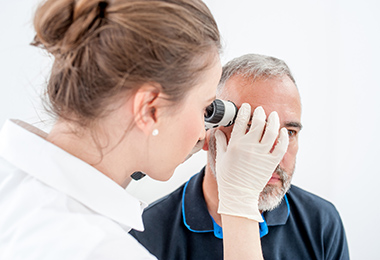Transoral Robotic Surgery (TORS)
Tumors in the throat, base of the tongue and tonsils can be difficult to reach surgically. Traditionally, their surgical removal entailed cutting the jaw, a large incision in the neck, long hospital stays, and extensive swallowing and speech rehabilitation. However, transoral robotic surgery (TORS) allows surgeons to reach these tumors through the mouth, using robotic instruments.
What You Need to Know
- Transoral robotic surgery (TORS) allows surgeons to access tumors in hard-to-reach areas of the mouth and throat without an incision.
- Human papillomavirus (HPV)-positive patients with small tumors on the back of the tongue or tonsils are ideal candidates for TORS.
- TORS is minimally invasive.
- Complications with TORS are less common than with standard open surgery.
What is transoral robotic surgery?
TORS is a minimally invasive surgery that uses a robot to access hard-to-reach tumors in the back of the throat or mouth. Using cameras attached to a robotic arm that provide a high-resolution, 3D image, the surgeon guides tools at the end of the robotic arms to remove the tumor. The precision of robotic surgery helps protect surrounding tissue while also safely removing the tumor. This approach minimizes the amount of tissue that is removed during cancer surgery.
Conditions Treated by TORS
TORS is used to treat many conditions, including:
- Oropharyngeal, hypopharyngeal and laryngeal tumors
- Sleep apnea
- Benign tumors or cysts in the throat
Who is a candidate for TORS?
Patients with small tumors on the back of the tongue or tonsils are ideal candidates. It is a go-to procedure for patients with HPV-positive tumors that the team identifies as amenable for this surgery. Other factors that determine eligibility include neck disease, mouth opening, overall health and extent of the tumor.
Benefits of Transoral Robotic Surgery
TORS offers many benefits compared with standard surgery, including:
- Reduced need of chemotherapy or further treatments
- Reduced cost
- Minimally invasive surgery
- Less scarring
- Shorter hospitalization
- Lower risk of infection
- Fewer swallowing side effects
- More precise tumor targeting
- Potential for reduced radiation after surgery
Preparing for Transoral Robotic Surgery
- Preliminary tests such as imaging scans help the surgeon plan the procedure.
- Patients can expect to meet the multidisciplinary team to discuss different approaches.
- A presurgical swallow evaluation and speech-language pathology consultation will assist with recovery and swallowing function.
- Do not eat or drink anything after 12 a.m. on the day of surgery.
- Tell your health-care provider if you take medications such as blood thinners.
- Follow other instructions provided by the surgeon.
What happens during transoral robotic surgery?
The patient is put to sleep on the operating table using anesthesia. Their mouth is opened for the robot to be able to access the throat. Controlling the arms of a surgical robot, the surgeon will remove the tumor in the back of the throat.

How long does transoral robotic surgery take?
Times can vary based on complexity and patient needs. TORS is commonly used for neck surgery to remove lymph nodes from the neck (neck dissection) and to tie-off branches of the external carotid artery (ECA). Tying off the ECA or its branches reduces risk of life-threatening bleeding.
Recovery from Transoral Robotic Surgery
Patients will be observed by the care team for one to two days in the hospital to monitor pain, swallowing and ensure there aren’t any medical issues.
Pain and difficulty swallowing are common after surgery for about two to three weeks. Many patients lose weight due to difficulty swallowing. To avoid excessive pain and weight loss, easy-to-swallow and digestible foods are important during the recovery. Most patients return to their usual activities after three to four weeks.
What happens after Transoral Robotic Surgery?
The pathology report is typically available one week after surgery. A multidisciplinary team will review the report and decide if radiation or chemotherapy is necessary after surgery. If radiation therapy is recommended it will typically start within 40 days after surgery.
Possible Transoral Robotic Surgery Complications
Although complications with TORS are less common compared with standard surgery, no procedure is without risks. Potential complications include:
- Breathing difficulty
- Bleeding
- Food or liquids entering the lungs
- Swallowing difficulties
When should I contact my health-care provider?
A health-care provider should be contacted immediately if any of these symptoms occur:
- Fever
- Surgical site bleeding
- Nausea and vomiting
- Dehydration
- Breathing difficulty
- Irregular swelling
Transoral Robotic Surgery (TORS) – FAQs
Johns Hopkins head and neck surgeon Carole Fakhry explains what TORS is, who is eligible for the surgery, the benefits of it and what to expect after TORS.







